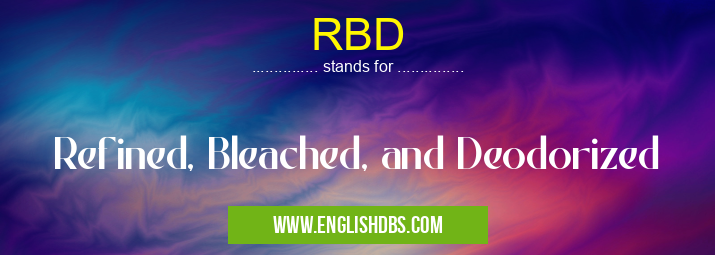What does RBD mean in FOOD & NUTRITION
Refined, Bleached, and Deodorized (RBD) is the process of removing the undesirable elements from a substance. This process includes refining the product into an edible form, bleaching out the color to make it more visually appealing, and deodorizing it to remove any strong odors from the product.

RBD meaning in Food & Nutrition in Miscellaneous
RBD mostly used in an acronym Food & Nutrition in Category Miscellaneous that means Refined, Bleached, and Deodorized
Shorthand: RBD,
Full Form: Refined, Bleached, and Deodorized
For more information of "Refined, Bleached, and Deodorized", see the section below.
Essential Questions and Answers on Refined, Bleached, and Deodorized in "MISCELLANEOUS»FOOD"
What is RBD?
What are the benefits of RBD?
RBD offers a number of different benefits. It increases the shelf life and quality of products by removing impurities that can cause spoilage and safety issues. It also allows these products to have a more consistent flavor profile as well as a uniform color throughout all batches. In addition, it makes them easier to store since their shape and specifications remain unchanged.
Which products commonly use RBD?
Products such as vegetable oils, coconut oil, palm oils, margarine, shortening, cocoa butter substitutes are often refined with this process. Other common food items that may go through this process include rice bran oil and animal fats.
What kind of processes are involved in RBD?
The processes involved in RBD typically include multiple stages. This includes degumming or neutralization which removes phospholipids from vegetable oils; alkali refining which removes free fatty acids; winterization or dewaxing which reduces waxes found within certain oils; bleaching which removes natural pigments and discoloration; pre-filtering; deodorization which eliminates odors caused by oxidation; adsorption polishing step which removes further impurities; and finally a cooling stage for proper solidification/liquefaction of certain products.
How does bleaching work in RBD?
Bleaching is an important part of RBD that helps to reduce unwanted colors in certain products. This is done by adding activated carbon to absorb unwanted compounds and then filtering out those absorbed compounds so that they don’t contaminate other parts of the product. Thus helping create a uniform color throughout all batches.
What kind of equipment is used for RBD?
Depending on the type of product being refined, different types of machinery can be used for various steps within this process. Generally speaking equipment such as decanters/centrifuge separators, filter presses or plate & frame filters may be used for clarification/filtration stages while mixing tanks or blenders could be used at earlier stages like alkali refining.
Does RBD affect nutritional value?
The RBD process has minimal effects on nutritional value since it’s mainly focused on removing unwanted elements rather than disrupting valuables ones. While small amounts of nutrients can be lost during this process they are usually negligibly low compared to what’s gained overall from having a safe edible product ready for consumption.
Are there any safety considerations when using RBD?
As with any processing method there should always be an emphasis on ensuring that safety standards are met when handling any substances before or after refines have been made. Properly stored raw materials should also be taken into account since those might contain contaminants that could lead to potential health risks if left unchecked.
Is there any environmental impact associated with this process?
There can be some minor environmental impacts associated with this type of processing but these tend to fall under minimal standards set forth by most countries’ governing bodies regarding emissions or water wastage etc… To ensure responsible operations companies should regularly monitor their production outputs along with properly disposing off waste material produced during refinement.
RBD also stands for: |
|
| All stands for RBD |
